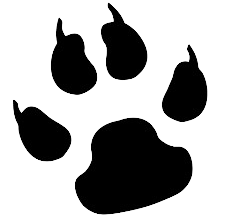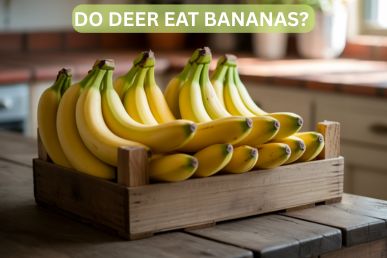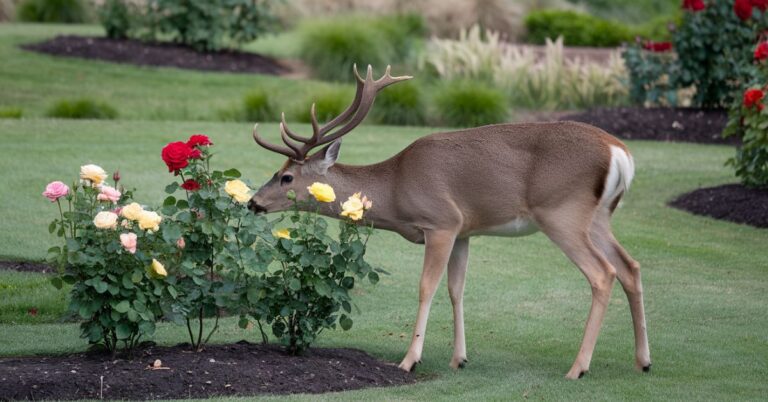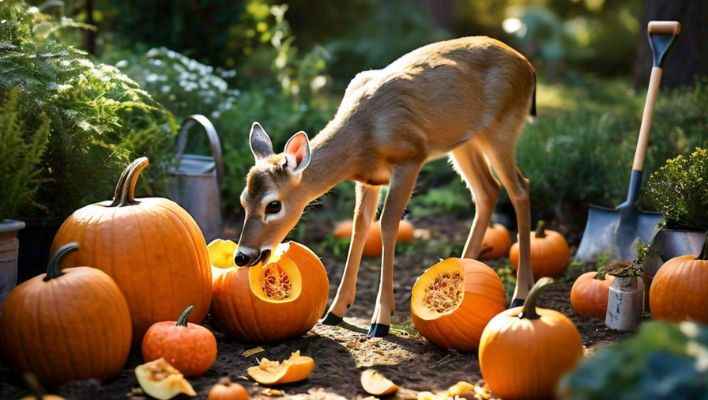Do Deer Eat Pears? Perfect for both hunters and landowners

The list of deer’s favorite fruits is very long, and pears are also part of that list. Deer are not picky eaters. So, do deer eat pears? Yes, deer can eat pears as well as other fruits such as apples, crabapples, and even blueberries, and citrus fruits like oranges, but it all depends on the situation.
If a deer gets something better to eat than these fruits, it will definitely prefer it. Deer’s diet consists of many things. You will be surprised to know that deer can eat more than 400 different species of plants in the Southeastern part of the U.S.
This wide-ranging diet even includes some unexpected fruits like bananas, depending on availability and region, and you should also know that they do not only eat fruits, but also plants, leaves, vegetables, nuts, and even the bark of trees is not safe from deer.
However, since the purpose of this article is to understand the relationship between deer and pears, you need to know that if you grow pear trees in your yard or garden, deer will definitely attack them.
But don’t worry, this article will tell you how to protect pear trees from deer and what types of pears to use if you want to attract deer.
When do deer eat pears and why?
We have often seen deer eating pears during the fall season from October to December. In places like Pennsylvania, the weather starts to cool down between October and December.
And when a pear falls from the tree during this season, it is as cold as if it had just been taken out of the refrigerator. This kind of natural cold storage makes the pears more tender, sweet, and flavorful.

Although deer will enjoy pears whenever they find them, October and November are the months when pears are sweeter and more delicious, which is why deer are attracted to them. So you need to take extra care of your pear trees during these months.
How can deer damage pear trees?
It is not necessary for a deer to eat only pears lying on the ground; it can stand on its hind legs and pluck a pear directly from the pear tree and eat it.
If deer eat your pear fruit, that’s obviously a problem, but another big problem is that they also like to eat the young, tender parts of the tree, such as new shoots and leaves, which stunts the tree’s growth and ultimately reduces the tree’s pear production.
The third major disadvantage is that during the mating season, male deer (bucks) often rub their antlers against the trunks of pear trees. By doing so, they can peel or break the bark, which can damage the tree’s future.
In view of these losses, it is crucial to protect young pear trees from deer, especially when they are small, as the chances of deer damaging them are high.
If you have pear trees in your yard or garden and you do not take adequate measures to protect them, they can definitely become deer prey.
How to protect pear trees from deer?
The most effective and easiest way to keep deer away from your pear trees is to install a fence. Deer cannot easily cross this barrier, so this method plays an important role in protecting your pear trees from damage.

People use different types of fences to deter deer, depending on their needs, budget, and area size. Some of which are as follows:
Use a Woven wire fence
This type of fence is the most effective at keeping deer away because it is a fence made of strong, crisscrossed wires. To stop deer from jumping over it, the fence should be at least 8 feet tall, because deer are surprisingly good at jumping and can easily clear shorter fences.
While installing the fence, make sure that the bottom of the fence touches the ground. If there is even a small gap under the fence where the deer can cross it, I don’t think you’ll benefit much from fencing. Therefore, the fence needs to touch the ground.
An electric fence can also be a good option
You can also use an electric fence to protect your pear trees from deer. Here’s how it works. Essentially, whenever a deer or any other animal touches the fence or tries to escape from under it, it receives a quick and harmless shock.
But don’t worry, this shock is not life-threatening to the deer. It will just prevent it from visiting your area in the future. Normally, a deer can jump quite high, but once it finds out that there is electricity in this fence, it will never attempt such an experiment.
An advantage of electric fencing is that it is cheaper than a tall 8-foot woven wire fence, which is why some people prefer it. Another pro tip is that if you use an electric fence and make it 6 to 8 feet long, that is another plus point.
In my opinion, one disadvantage of an electric fence is that since it contains electricity, sometimes if the electricity goes out, the current can be lost, and if a deer wants to attack your pear trees during this time, it can do so easily because since there is no current in the fence during this time, it can easily cross it. Therefore, maintenance and checking of the electric fence are very important to keep it functional.
Repellents
You can also keep deer away from pear trees by using repellents. Basically, repellents are things that deer don’t like the smell or taste of, which is why deer don’t come near them.
Some common repellents people use include:
- Blood meal
- Bone tar oil
- Meat scraps
- Ammonium
- Urine (like predator urine)
- Rotten eggs
- Hot pepper sauce
However, these repellents only provide temporary protection. When you use them frequently, the deer will get used to them and realize that they can’t do much harm to them.
So, to maintain the effectiveness of the repellents, keep shuffling them around. For example, use one repellent for two days and then start using another repellent. By doing this, you can annoy the deer, and they will prefer to stay away from your trees.
What Are the Best Pear Varieties for Attracting Deer?
Ayers and Early Bow Pears
- These pears taste good, and deer like to eat them.
- When pear season begins, this type of pear ripens quickly, which makes it easy for deer to get attracted to it.
Kieffer Pear
- When this pear ripens and turns yellow, it falls to the ground, which makes it very attractive to deer.
- They drop in the middle of the season, keeping deer interested when early pears are done.
Advent and Malus
- These varieties start ripening after the Kieffer pears are done.
- These types of pears attract deer from nearby areas.
Big Lou Pear
- The fruits of this type of pear begin to fall in December and continue to fall until January.
- This pear can attract deer even after the hunting season is over.
Winter Deer Pear
- These pears start falling in January and continue into March.
- This pear tastes good until late winter, and white-tailed deer love to eat it. This pear keeps them close to you when they can’t find anything else to eat.







